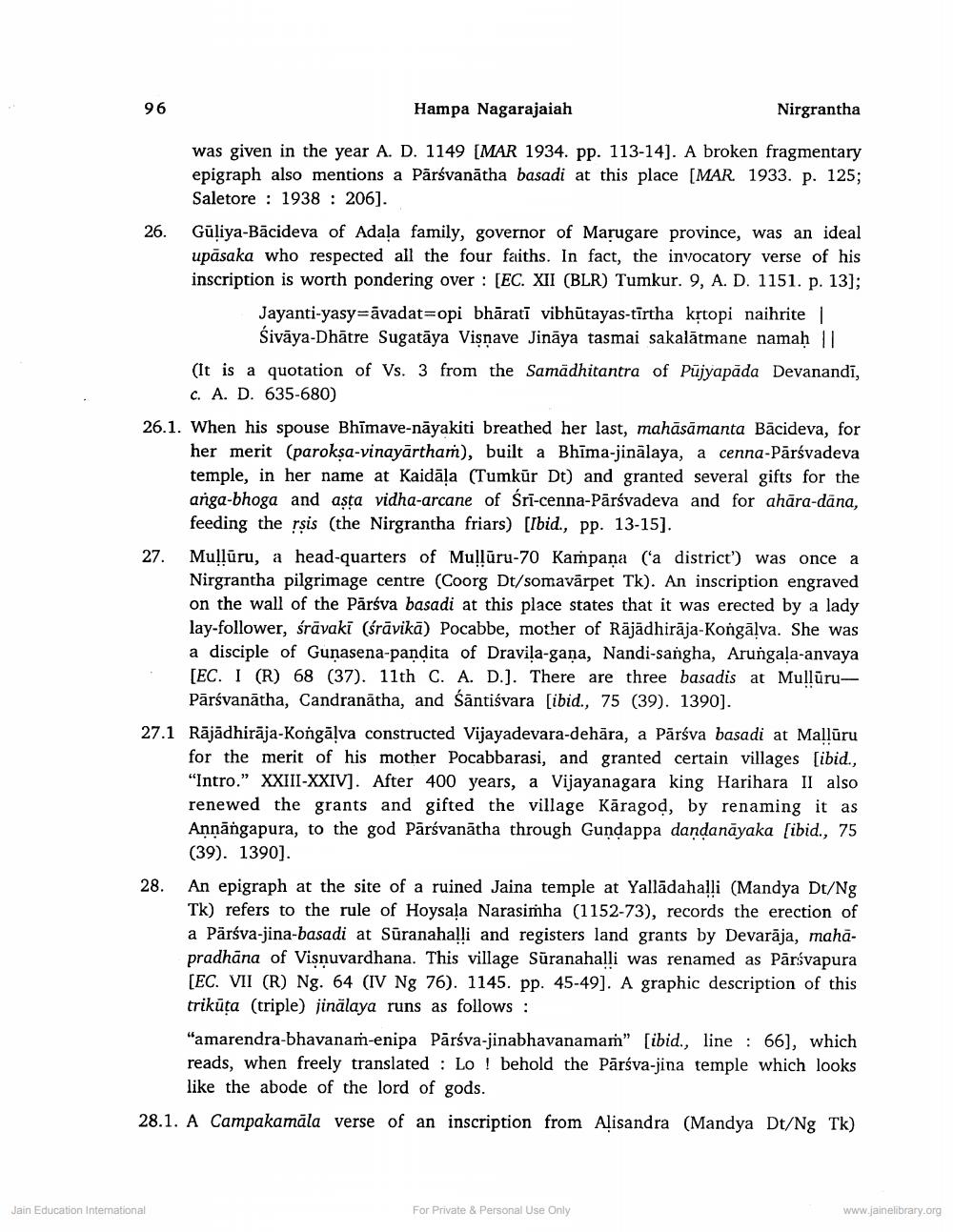________________
96
Hampa Nagarajaiah
Nirgrantha
was given in the year A. D. 1149 (MAR 1934. pp. 113-14). A broken fragmentary epigraph also mentions a Pārsvanātha basadi at this place [MAR. 1933. p. 125;
Saletore : 1938 : 206]. 26.
Gūliya-Bācideva of Adala family, governor of Marugare province, was an ideal upāsaka who respected all the four faiths. In fact, the invocatory verse of his inscription is worth pondering over : [EC. XII (BLR) Tumkur. 9, A. D. 1151. p. 13);
Jayanti-yasy=āvadat=opi bhārati vibhūtayas-tīrtha krtopi naihrite |
Śivāya-Dhātre Sugatāya Visnave Jināya tasmai sakalātmane namaḥ 11 (It is a quotation of Vs. 3 from the Samadhitantra of Pūjyapāda Devanandī,
C. A. D. 635-680) 26.1. When his spouse Bhimave-nāyakiti breathed her last, mahāsāmanta Bācideva, for
her merit (parokşa-vinayārtham), built a Bhīma-jinālaya, a cenna-Pārsvadeva temple, in her name at Kaidāļa (Tumkūr Dt) and granted several gifts for the anga-bhoga and asta vidha-arcane of Śrī-cenna-Pārsvadeva and for ahāra-dana,
feeding the rșis (the Nirgrantha friars) [Ibid., pp. 13-15]. 27. Mullūru, a head-quarters of Mullūru-70 Kampaņa ('a district') was once a
Nirgrantha pilgrimage centre (Coorg Dt/somavārpet Tk). An inscription engraved on the wall of the Pārsva basadi at this place states that it was erected by a lady lay-follower, śrāvaki (śrāvikā) Pocabbe, mother of Räjādhirāja-Kongālva. She was a disciple of Gunasena-pandita of Dravila-gana, Nandi-sangha, Arungala-anvaya [EC. I (R) 68 (37). 11th C. A. D.). There are three basadis at Mullūru
Pārsvanātha, Candranātha, and śāntiśvara (ibid., 75 (39). 1390). 27.1 Rājādhirāja-Kongālva constructed Vijayadevara-dehāra, a Pārsva basadi at Mallūru
for the merit of his mother Pocabbarasi, and granted certain villages (ibid., "Intro." XXIII-XXIV). After 400 years, a Vijayanagara king Harihara II also renewed the grants and gifted the village Kāragod, by renaming it as Anņāngapura, to the god Pārsvanātha through Gundappa dandanāyaka (ibid., 75 (39). 1390]. An epigraph at the site of a ruined Jaina temple at Yallādahalli (Mandya Dt/Ng Tk) refers to the rule of Hoysala Narasimha (1152-73), records the erection of a Pärsva-jina-basadi at Sūranahalli and registers land grants by Devarāja, mahapradhana of Visnuvardhana. This village Süranahalli was renamed as Pārsvapura [EC. VII (R) Ng. 64 (IV Ng 76). 1145. pp. 45-49). A graphic description of this trikūta (triple) jinālaya runs as follows: "amarendra-bhavanam-enipa Pārsva-jinabhavanamam" (ibid., line : 66), which reads, when freely translated : Lo ! behold the Pārsva-jina temple which looks
like the abode of the lord of gods. 28.1. A Campakamäla verse of an inscription from Aļisandra (Mandya Dt/Ng Tk)
28.
Jain Education Intemational
For Private & Personal Use Only
www.jainelibrary.org




